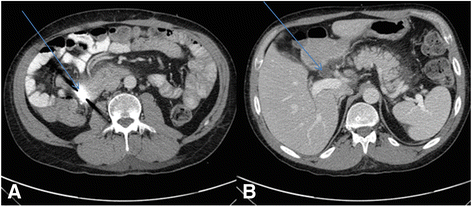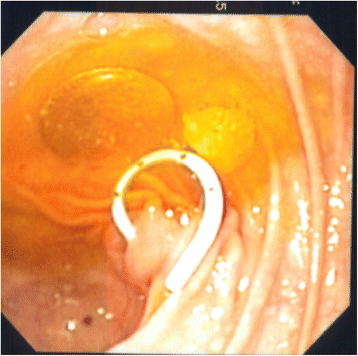Pancreatic and biliary obstruction years after retention of a swallowed coin in a duodenal diverticulum: a case report
- PMID: 26084396
- PMCID: PMC4481078
- DOI: 10.1186/s13256-015-0608-6
Pancreatic and biliary obstruction years after retention of a swallowed coin in a duodenal diverticulum: a case report
Abstract
Introduction: Congenital duodenal diverticula are a rare anomaly. The discovery of one in association with an ingested foreign body has only been reported on one previous occasion. In this challenging presentation, the presence of the coin led to the correct diagnosis. Patients with congenital duodenal anomalies may present a number of associated abnormalities. Interestingly, after the discovery of his intraluminal duodenal diverticulum, we searched and found that our patient presented a number of associated pathologies, as described in the literature.
Case presentation: Our patient was a 36-year-old man, Caucasian, a kidney transplant recipient who presented with abdominal pain, vomiting and fever after an episode of pancreatitis. Because of a history of behavioral problems associated with intellectual impairment, including a compulsion to swallow coins during childhood, an abdominal radiograph was performed. Surprisingly, the radiograph revealed a radiopaque shadow in the central abdominal area. The findings of the ultrasound examination and computed tomography scan were suggestive of dilated biliary and pancreatic ducts. We performed an endoscopic retrograde cholangiopancreatography, which led to confirmation of the suspected coin above an obstructing intraluminal duodenal diverticulum with associated biliary ductal dilation. Upon retrieval of the coin, it was found to be a 1975 copper two-cent piece out of circulation in Australia for a large number of years.
Conclusions: Foreign body retention in the gastrointestinal tract in an adult could be a sign of underlying mechanical pathology. Intraluminal duodenal diverticulitis can have a varied presentation, including life-threatening complications. Awareness should be raised of the conditions associated with congenital duodenal anomalies in adults, including renal, hepatobiliary and cardiac defects, many of which were present in our case.
Figures



References
Publication types
MeSH terms
LinkOut - more resources
Full Text Sources
Other Literature Sources
Medical

